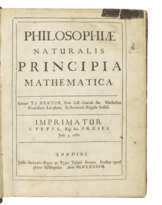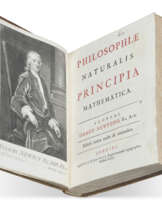ID 887838
Los 65 | Principes Mathématiques de la Philosophie Naturelle
Schätzwert
$ 4 000 – 6 000
First edition of du Châtelet’s translation and commentary on Newton’s Principia, the first translation of that work into French—a fine, uncut copy in its original blue paper wrappers. Far more than a translation alone, this posthumously published work is perhaps the greatest legacy of Émilie du Châtelet. “For a long time, [her] French translation and her commentary on Newton’s Philosophiae naturalis principia mathematica provided the only access to Newton’s principles of natural philosophy in French and, together with her commentary on Leibniz’s philosophy in the Institutions de physique, it thus greatly influenced scientific discourse in the eighteenth century and can be said to have furthered both transnational and European scientific collaboration" (Winter).
Her commentaries and new discoveries are contained largely in the second volume, in two separately paginated sections. Here, perhaps most importantly, du Châtelet states for the first time—having tested it herself—the principle of conservation of energy: the law in physics and chemistry that the total energy of an isolated system remains constant. This means that energy can neither be created nor destroyed; rather, it can only be transformed or transferred from one form to another. Du Châtelet’s commentary throughout elucidates and clarifies Newton’s text, providing missing proofs and generally making it more mathematically coherent. She applied the advanced mathematics of the Bernoullis, Leonhard Euler, and others to make Newton’s work more accessible. Particularly notable is her use of Leibnizian calculus instead of Newton’s own method of fluxions.
Du Châtelet had begun to fully devote herself to this project in 1745; tragically, she died of puerperal fever after an intense period of work on the manuscript, which she entrusted to the librarian of the Bibliothèque du Roi in Paris the day before her death. The text was revised by Alexis Clairaut (who had also assisted her during her lifetime) for publication. The present copy contains the Advertissement, probably by Clairaut, in its first state, with "Clairaut" misspelled "Clairault" and also with the reference to “la première partie de l’Ouvrage que M. d’Alembert vient de publier sous le titre de Recherche sur quelques points importants du Système du monde” (published in January 1745). The second state refers to the completed work, including the second part, that was only published on 17 November 1756. The text also includes Voltaire’s Preface historique, recounting the history of du Châtelet’s translation of Newton and Clairaut’s role in it and providing a survey of Newton’s philosophical position. Also present are translations of Newton’s prefaces to all three editions he published (1687, 1713, and 1726), and also Cotes’s preface from the 1713 edition, which is often missing.
Although some bibliographers report a small “presentation” edition with title page dated 1756, Laetitia Comolet-Tirman, in her 2017 master's thesis, has convincingly demonstrated that there is only one edition, published in 1759, but made up of sheets mostly printed in or before 1756. Although publication had been planned for 1756, it did not happen due to drawings for some of the plates being misplaced, delaying their printing. This is stated clearly on the verso of the last leaf of Voltaire’s preface, which contains the Errata to vol I and also an “Avertissement sur les Planches et cet Ouvrage.” The errata states that “Les Planches qui étoient absolument nécessaires dans cet Ouvrage, & d’autres obstacles qu’on ne pouvoir pas prévoir, ont empêché jusqu’ici [i.e. 1759] la publication des Principes de Newton, qu’on su proposoit de mettre en vente dès l’année 1756.” It was still unpublished at the time of Voltaire’s 1757 memoir, in which he mentions that the project was still unachieved. As evidenced by the issue states of some of the text in the so-called “1756” copies being printed later than the corresponding ones in 1759 copies, they must have been put together with remainder sheets, in or even after 1759.
Babson 28. See Laetitia Comolet-Tirman, "La publication des Principes mathématiques de la philosophie naturelle, par Emilie du Châtelet, femme de science au XVIIIe siècle," (2017 thesis); Bernard Cohen, "The French Translation of Isaac Newton’s Philosophiae Naturalis Principia Mathematica (1756, 1759, 1966)," in Archives internationales d’Histoire des Sciences, vol 21 (1968), pp 262-290; Winter, "From translation to philosophical discourse – Emilie du Châtelet’s commentaries on Newton and Leibniz," pp. 173-206 in Emilie du Châtelet between Leibniz and Newton (2012).
Two volumes, quarto (270 x 218mm). Half titles. 9 folding engraved plates in vol. 1 and 5 in vol. 2, woodcut title ornaments and head- and tail-pieces. Original blue paper wrappers (some losses to paper on spines).
| Künstler: | Émilie du Châtelet (1706 - 1749) Isaac Newton (1643 - 1727) |
|---|---|
| Kategorie des Auktionshauses: | Medizin und Wissenschaft |
| Künstler: | Émilie du Châtelet (1706 - 1749) Isaac Newton (1643 - 1727) |
|---|---|
| Kategorie des Auktionshauses: | Medizin und Wissenschaft |
| Adresse der Versteigerung |
CHRISTIE'S 8 King Street, St. James's SW1Y 6QT London Vereinigtes Königreich | |
|---|---|---|
| Vorschau |
| |
| Telefon | +44 (0)20 7839 9060 | |
| Aufgeld | see on Website | |
| Nutzungsbedingungen | Nutzungsbedingungen |



![[NEWTON, Isaac (1642-1727)]](/assets/image/picture_4036009/5c8e6/3e601c7a9444e346ef4136ceaf96156f1720562400jpg__fix_162_205.jpeg)








